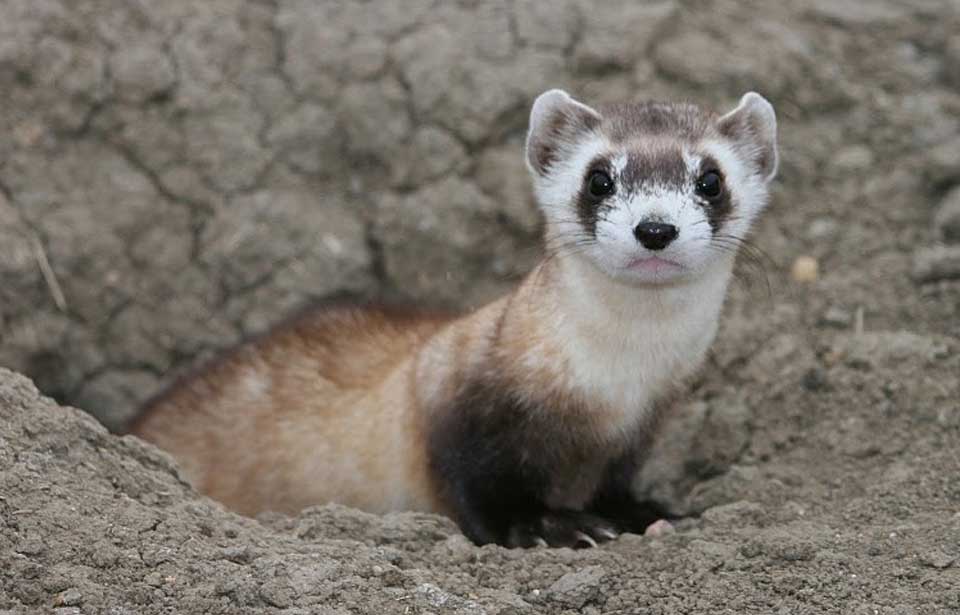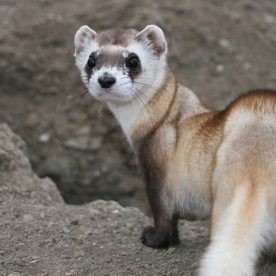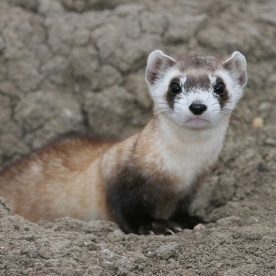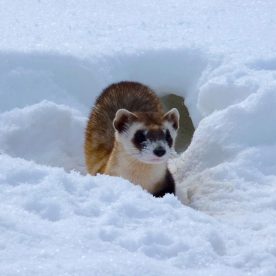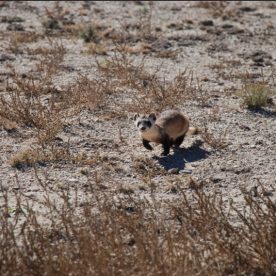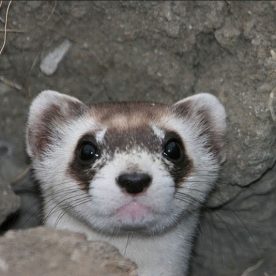Description
Of the three ferret species in the world, the black-footed ferret (Mustela nigripes) is the only one indigenous to North America. In contrast, the domestic ferret (Mustela putorius) is of European origin, though both species belong to the mustelid family, which also includes the mink, weasel, otter, wolverine and one of the black-footed ferret’s main predators, the badger.
Black-footed ferrets are impeccably cute: cat-like whiskers sprouting from a white muzzle, plush round ears above eyes set into a bandit’s black mask and sturdy legs in black stockings, supporting a sinuous, sandy-coloured body crowned by a black-tipped tail.
Their shape, colouring and behaviour are all finely tuned for life in the grasslands. Their yellow-buff fur blends so seamlessly with the prairie landscape that they can be hard to spot while immobile, which protects them from predators like badgers, foxes and coyotes. They can slide into prairie dog burrows with their long, slinky bodies and use their sharp teeth, strong jaws and non-retractable claws to kill and devour the occupants. They then make comfortable shelters of these burrows, their long necks allowing them to check for above-ground threats before emerging.
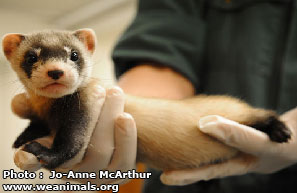 Black-footed ferrets measure 28 to 50 centimetres, and their tails are between 11 and 15 centimetres long. Males weigh from 950 to 1,100 grams, while females weigh from 750 to 900 grams. The ferrets’ concave ears and large eyes give them an acute sense of hearing and sight, while their nose is specially developed to detect prairie dogs underground during their nocturnal hunts. Like all members of the mustelid family, black-footed ferrets have scent glands under their tales, which secrete a musk useful for marking territory.
Black-footed ferrets measure 28 to 50 centimetres, and their tails are between 11 and 15 centimetres long. Males weigh from 950 to 1,100 grams, while females weigh from 750 to 900 grams. The ferrets’ concave ears and large eyes give them an acute sense of hearing and sight, while their nose is specially developed to detect prairie dogs underground during their nocturnal hunts. Like all members of the mustelid family, black-footed ferrets have scent glands under their tales, which secrete a musk useful for marking territory.
Signs and sounds
Black-footed ferrets make a high-pitched chatter to express anxiety or excitement. During their release into the wild (see “Conservation”), when captive-bred ferrets were hesitant to leave the perceived safety of the travel case, their anxious chatter warned handlers against giving them an encouraging nudge.
As their library of sounds and signs suggests, black-footed ferrets are very playful, especially while young. Females whimper and chortle to corral their kits, who wrestle, chase one another and occasionally engage in a mischievous “Ferret Dance,” in which they arch their backs, open their mouths and hop backwards.
Habitat and Habits
Before reaching near-extinction, black-footed ferrets lived throughout the temperate grasslands of Canada’s prairie ecozone and the American Great Plains. They rely almost exclusively on prairie dog colonies for food, shelter and storage; not only do the plump rodents make up nearly all of the ferrets’ diet, but their burrows provide safe, prefab protection from predators and harsh weather and serve as a pantry for caching food. As such, black-footed ferrets survive only where prairie dog populations are sufficiently strong.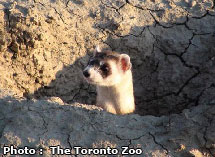
Because they are nocturnal and spend up to 90 per cent of their time underground, close observation is often difficult for researchers. A team from Environment Canada that was monitoring burrowing owl nests happened to capture black-footed ferrets on their motion-activated night cameras soon after the ferrets’ reintroduction into the Canadian grasslands (see “Conservation”). The resulting photographs show typical black-footed ferret behaviour: emerging cautiously from their burrows, scanning the landscape for threats and digging through snow to investigate the ground beneath. These “accidental” photographs suggest new possibilities for monitoring newly introduced black-footed ferrets in Canada.
While they don’t hibernate, black-footed ferrets significantly limit their activity during winter in order to conserve as much energy as possible. In temperate seasons, though, they are very active. Males travel farther than females, sometimes covering up to eight kilometres a night and investigating dozens of prairie dog burrows.
Range
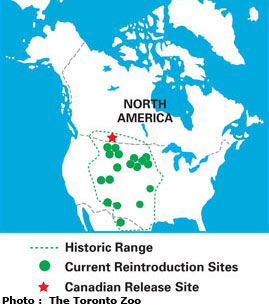 Historically, their range extended from northern Mexico to the southern grasslands of Saskatchewan and Alberta, sweeping across the American Great Plains. As European settlers began exterminating prairie dogs, whose burrows hampered efforts to convert wild grassland to profitable food crops, black-footed ferrets lost nearly all of their primary food source and began to disappear. By the early 19th century, prairie dogs had been driven to only two per cent of their former territory, and conservationists considered black-footed ferrets globally extinct.
Historically, their range extended from northern Mexico to the southern grasslands of Saskatchewan and Alberta, sweeping across the American Great Plains. As European settlers began exterminating prairie dogs, whose burrows hampered efforts to convert wild grassland to profitable food crops, black-footed ferrets lost nearly all of their primary food source and began to disappear. By the early 19th century, prairie dogs had been driven to only two per cent of their former territory, and conservationists considered black-footed ferrets globally extinct.
In 1981, those conservationists were proven wrong when a rancher’s dog returned from a hunt and dropped a black-footed ferret at his owner’s feet. As a result, researchers discovered a small colony in Wyoming, which they used to found a captive-breeding program, eventually facilitating several supervised reintroduction sites throughout North America. In October 2009, researchers from the Toronto Zoo, Parks Canada, USFWS and many other partners released 34 black-footed ferrets from captivity into Grasslands National Park, Saskatchewan. See “Conservation” for more details.
Feeding
Black-footed ferrets are “obligate” carnivores, meaning they consume one type of prey almost exclusively—in their case, the prairie dog. This meal of choice makes up over 90 per cent of their diet; a black-footed ferret family of four will consume about 763 prairie dogs per year. They may also occasionally eat ground squirrels, small rodents, cottontail rabbits and birds.
Unlike their prey of choice, black-footed ferrets are nocturnal, which allows them to take sleeping prairie dog colonies by surprise. They choose to attack their prey underground, giving it little chance of escape inside the narrow tunnels of the burrow. These two important habits—hunting nocturnally and attacking underground—give the small ferret crucial advantages over prairie dogs, which can be as much as 1.5 times their size.
Researchers estimate that a prairie dog colony must cover at least 4,000 hectares of land in order to support a self-sustaining black-footed ferret population. For researchers involved in the black-footed ferret’s Canadian reintroduction, this requirement posed a problem because current prairie dog habitats are greatly limited by agricultural conversion.
In the end, Grasslands National Park in Saskatchewan was chosen as the first Canadian reintroduction site even though its protected prairie dog population covers only 2,000 hectares. It is plague-free and has the most promise as a small, carefully managed release site where a modest black-footed ferret population will find enough food to survive.
Breeding
Ferrets take their cue from the sun to begin the breeding season. Unlike humans, female black-footed ferrets do not ovulate and males do not show testicles until just prior to breeding season, which lasts from late January to early June (but peaks between March and April). Gestation lasts from 42 to 45 days, culminating in a litter of one to seven kits (the average is three to four). Kits are born blind and hairless; they endure this helpless state safely sequestered in a prairie dog burrow until, at about two months old, they are allowed above ground. 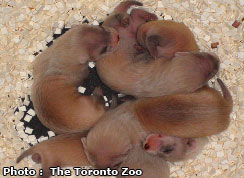
While the male ferret plays no part in raising young, the female is a skillful mother. Under her supervision, the playful and insatiably curious kits chase one another, stage attacks on simulated prey and studiously imitate adult ferrets—all of which prepare them for life on their own, which usually begins in mid-autumn.
All black-footed ferrets alive today are captive-bred descendents of a small colony, and much of what we know about their breeding habits comes from observation in captivity. Researchers at the Toronto Zoo use lamps installed within the enclosures to simulate daylight and signal the start of breeding season. Captive black-footed ferrets receive fourteen hours of light a day from December 21 to the first week of January, when the breeding season begins.
Each ferret is then captured, measured for optimal breeding weight and studied for signs of reproductive readiness. When a female’s vulva measures five millimetres, researchers take cell samples to check her breeding condition. Males must submit to a thorough testicle examination in which researchers measure width, length and firmness, then use a procedure called “electroejaculation” to test for sperm and examine its quality.
Ferrets that pass these tests are ready to breed. Geneticists determine which ferrets are paired for breeding, though handlers often face amusing challenges when trying to encourage strong-willed ferrets to mate with a specific partner.
Conservation
The black-footed ferret has a perilous hold on survival, though collaborative captive-breeding programs across North America have greatly improved this species’ prognosis in the last several decades. As of early 2010, there are 19 supervised reintroduction sites across North America, including one in Grasslands National Park,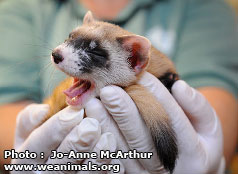 Saskatchewan. These sites represent more than 1,000 ferrets now living in the wild—a significant step back from the brink of extinction, which was a very real possibility until researchers intervened late in the 20th century.
Saskatchewan. These sites represent more than 1,000 ferrets now living in the wild—a significant step back from the brink of extinction, which was a very real possibility until researchers intervened late in the 20th century.
The story of their difficult survival, which begins with the development of agriculture in North America, illustrates the importance of a balanced food web in the wild. While farmers did not persecute the black-footed ferret directly, they targeted prairie dogs with extensive extermination efforts, eventually reducing their North American population to a fraction of its original size. Because black-footed ferrets rely on the prairie dog for most of their diet, this decline had devastating effects on their survival. Wild black-footed ferrets were last seen in Canada in the early 20th century, and by 1978 they had been declared extirpated, meaning they had disappeared from the country altogether. In fact, conservationists began to agree that they were globally extinct.
All of that changed when a farmer’s dog in Wyoming returned from a hunt with a black-footed ferret in its jaws. Researchers discovered a colony of 129 wild ferrets, though all but 18 of them perished from a disease epidemic soon after they were found. Researchers captured the survivors, only seven of which reproduced in captivity. Amazingly, these seven founders of the population were genetically diverse enough to form the basis of a continental captive-breeding program; all black-footed ferrets alive in North America today are descendents of those original seven.
The Toronto Zoo and five other North American captive-breeding facilities are engaged in an ambitious reintroduction program, which requires cooperation across the continent. Black-footed ferrets from the Toronto Zoo prepare for reintroduction at a preconditioning “boot camp” in Colorado, where they must learn to hunt, find shelter and flee predators. Before this preconditioning facility was established, nearly 90 per cent of reintroduced ferrets perished within two weeks of their release because of poor survival skills in the wild. Because of today’s ferret boot camp, their chances of survival in the wild are 10 times higher. 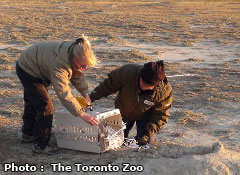
Before reintroduction, black-footed ferrets also receive vaccines to protect them from diseases like the plague and distemper, which are nearly 100 per cent fatal to ferrets and prairie dogs infected by contaminated fleas. Researchers are currently developing an oral plague vaccine for prairie dogs—until then, the fate of prairie dogs and the wild black-footed ferret population remains in doubt.
The first Canadian reintroduction took place on October 2, 2009, when 34 micro-chipped black-footed ferrets were released in Grasslands National Park, Saskatchewan. Hopes are high that most of them will survive the winter, establishing the first wild black-footed ferret population to live in the Canadian Prairies in more than seven decades.
Resources
Online Resources
Species at Risk Registry, Black-footed Ferret
Parks Canada, Species at Risk, The Black-footed Ferret
The Black-Footed Ferret Recovery Program
The Calgary Zoo. Black-footed Ferret
The Calgary Zoo: Night photos of the black-footed ferret
Canadian Geographic, Black-footed Ferret
The Discovery Channel’s Daily Planet documentary, Black-footed Ferret
The Toronto Zoo Black-footed Ferret
© Her Majesty the Queen in Right of Canada, represented by the Minister of the Environment, 2010. All rights reserved.
Text: Megan Findlay, with editing and background information provided by Maria Franke, MSc., of the Toronto Zoo.
Special thanks to Jo-Anne McArthur of www.weanimals.org and the Toronto Zoo for the photos included on this page.



